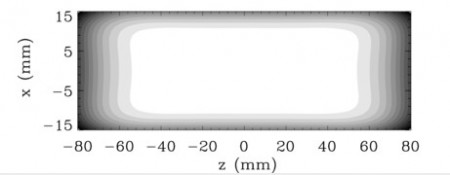Jan
8
A New Way to Catch and Hold Antimatter
January 8, 2013 | Leave a Comment
A group of researchers from the USA and Canada have proposed a method for cooling trapped the antimatter antihydrogen making it much more stable and a lot easier to experiment on. The new method developed by the group could potentially cool trapped antihydrogen atoms to temperatures 25 times colder than what is already achieved. The new idea could provide ‘a major experimental advantage’ and help to map the mysterious properties of antimatter that have to date remained elusive.
The new suggested method has been published in IOP Publishing’s Journal of Physics B: Atomic, Molecular and Optical Physics. In simple terms the method involves a laser, which is directed at antihydrogen atoms to give them a ‘kick’, causing them to lose energy and cool down. That may seem counter intuitive, but its anti matter.
To start with antihydrogen atoms are formed in an ultra-high vacuum trap by injecting antiprotons into positron plasma. An atomic process causes the antiproton to capture a positron, which yields an electronically excited antihydrogen atom. Typically, the antihydrogen atoms have a lot of energy compared to the trapping depth, which can distort the measurements of their properties. As it is only possible to trap very few antihydrogen atoms, the main method for reducing the high energies is to laser cool the atoms to extremely low temperatures.
Professor Francis Robicheaux of the U.S. Auburn University and co-author said, “By reducing the antihydrogen energy, it should be possible to perform more precise measurements of all of its parameters. Our proposed method could reduce the average energy of trapped antihydrogen by a factor of more than 10. The ultimate goal of antihydrogen experiments is to compare its properties to those of hydrogen. Colder antihydrogen will be an important step for achieving this.”
The process is known as Doppler cooling, an established method for cooling atoms, however, because of the restricted parameters that are needed to trap antimatter, the researchers need to be absolutely sure that it is possible.
Professor Robicheaux takes up that point with, “It is not trivial to make the necessary amount of laser light at a specific wavelength of 121 nm. Even after making the light, it will be difficult to mesh it with an antihydrogen trapping experiment. By doing the calculations, we’ve shown that this effort is worthwhile.”
Through a series of computer simulations, they showed that antihydrogen atoms could be cooled to around 20 millikelvin. Trapped antihydrogen atoms so far have energies up to 500 millikelvin making the new process much more likely to be useful.
Progress in understanding antimatter is picking up. In 2011, researchers from CERN reported that they had trapped antimatter for over 1000 seconds, over 16 ½ minites – a record. A year later, the first experiments were performed on antihydrogen while trapped between a series of magnets.
Even though the processes that control the trapping are largely unknown, the researchers believe that the laser cooling should increase the amount of time antihydrogen can be trapped.
“Whatever the processes are, having slower moving, and more deeply trapped, antihydrogen should decrease the loss rate,” said Professor Robicheaux.
The new advantages look promising. Colder antihydrogen atoms could also be used to measure the gravitational property of antimatter. “No one has ever seen antimatter actually fall in the field of gravity,” said co-author Dr Makoto Fujiwara of TRIUMF, Canada’s National Laboratory for Particle and Nuclear Physics. “Laser cooling would be a very significant step towards such an observation.”
Lots of folks are expecting that antimatter will have a future in energy or the fuel fields. Popular science fiction with the Star Trek family leading the way has set up some impressive goals. Now decades after the antimatter energy ideas first floated we’re just getting a look at the stuff. Where is will lead in the coming years promises to be quite interesting.
The Institute of Physics kindly listed the quick facts and big question about antimatter as understood today.
· Every particle has an antiparticle. For example, an electron’s antiparticle is the positron and a proton’s antiparticle is an antiproton.
· An antiparticle is exactly the same as its corresponding particle but carries an opposite charge.
· If a particle and its corresponding antiparticle meet, they destroy each other. This is known as annihilation.
· The combination of one positron and one antiproton creates antihydrogen.
· Theories suggest that after the Big Bang, equal amounts of matter and antimatter should have formed. As the Universe today is composed almost entirely of matter, it remains a great mystery why we don’t have this symmetry.
· Scientists such as the ALPHA collaboration at CERN have been trying to measure the properties of antihydrogen to find clues as to why this asymmetry exists.


